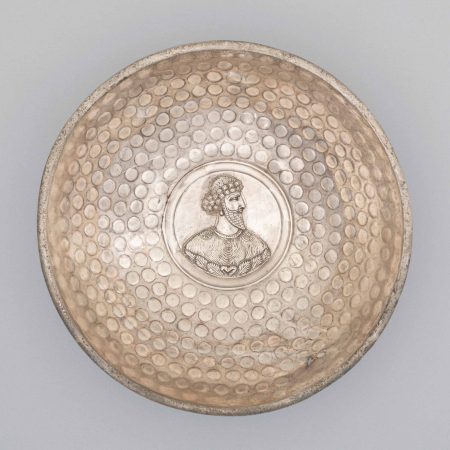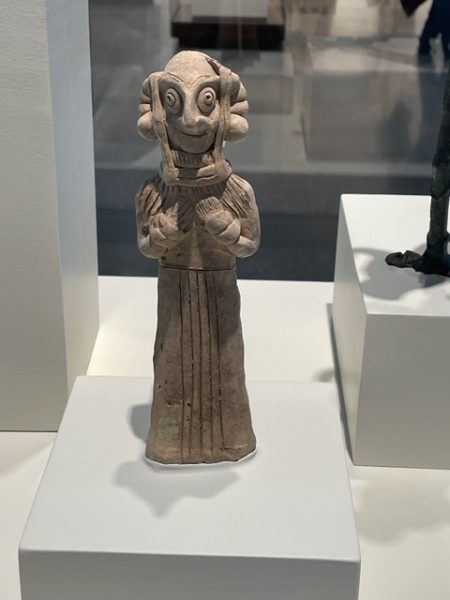
Visitors to the Cincinnati Art Museum may have noticed that the first gallery on the right past the entrance – the Middle East Gallery – has been closed about a year. In a marvelous four-year research project, the museum made significant physical and curatorial changes to the museum’s existing 2,800-square-foot ancient Middle East that reopened to the public this December 18.[i] The new space more powerfully showcases works from across the ancient Middle East, including the most significant collection of Nabataean art in the United States. For those not steeped in Middle Eastern and particularly Nabataean art, Raider’s of the Lost Ark with Harrison Ford as archeologist made Petra, the center of Nabataean culture and commerce, immediately recognizable.
How did it come about that the Cincinnati Art Museum has the largest collection of Nabataean art in the United States? This is in part thanks to the famous Cincinnati archaeologist Nelson Glueck who donated many pieces to the museum. While this article is about the re-opening of the Middle Eastern collection, it would be a mistake to overlook larger-than-life Nelson Glueck. Born in 1900, Glueck was an American rabbi, academic and archaeologist. He served as president of Cincinnati’s Hebrew Union College from 1947 until his death in 1971, and his pioneering work in biblical archaeology resulted in the discovery of fifteen hundred ancient sites. That is an almost unimaginable number!
By 1950, Glueck had excavated remains of the civilization of the ancient Nabataeans in Transjordan, described a biblical copper-mining industry at the shore of the Red Sea, and shown how the Negev Bedouin could support a large population if proper irrigation techniques were used. Glueck was personal friends of David Ben-Gurion, the primary founder of the State of Israel and the first Prime Minister of Israel. Abba Eban, Israeli diplomat and politician, and a scholar of the Arabic and Hebrew languages, Golda Meir, the fourth prime minister of Israel and Henrietta Szold, who founded the Women’s Zionist Organization of America, among other notables worldwide. Without Glueck’s vision, diligence and international prominence, the Middle Eastern Gallery would not be what it is.
What can the public hope to gain from the revamped galleries? The new galleries are arranged thematically and incorporate contemporary reflections on ancient pasts, encouraging visitors to rethink the way a twenty-first century museum interprets ancient Middle Eastern art[ii].2 This is no small task. So we have vitrines with thematic tiles like “Before Empire,” “Light and Ritual,” “Animal Imagery on Vessels,” and “Decoration for Horse and Human.” From these groupings we see what was of significance to these ancient people and what their spiritual and daily practices were like. The reinstallation includes objects displayed for the first time alongside much lauded strengths of the permanent collection to celebrate the art, innovation, and human endeavor from this vast region. This approach presents political, religious, economic, and cultural connections between the network of empires and city-states of the ancient Middle East. The objects and architectural material in the collection represent centuries of trade and cultural exchange that are formative in our understanding of how the region developed.

Entering the gallery, visitors are greeted by a vitrine with the theme “Portraying Feminine Power.” Examining one of the oldest objects in the gallery, the terra cotta Female Figurine from Syria, made between 2350-2100BCE, has the stark and riveting simplicity we associate with archaic objects. The figurine is apparently intended to represent a particular woman whose hands are in a prayerful position with both hands resting on her breasts. In this pose, the supplicant is communicating with a deity. Her long robe is carefully inscribed with lines to represent the folds in the cloth. Her garment has a ruffled neckline, also captured attentively in clay. Her eyes are large riveting spheres of clay and her hair is in elaborate folds. Most of us have worked with clay even if we only used it in elementary school. So we know how malleable clay is and how it can come alive with expressiveness as it does here in this small votive statue.

At the back of the gallery you cannot miss the beautiful central shrine façade, which has careful reconstruction elements attached so that you can imagine the shrine in its entirety. The inner part of the carved limestone shrine is magnificent alone. With the outline of the rest of the structure that surrounds it, we can envision what this architectural masterpiece looked like to ancient Nabataeans. This shrine also interweaves two titans of Nabatean archeology, Cincinnati’s own Nelson Glueck, who first came to the site in 1936 and Oxford’s Judith McKenzie, who took up the research two generations later to profound effect.[iii]
From the University of Oxford we have the following information:
Khirbet et-Tannur is a hilltop sanctuary on the King’s Highway, near Khirbet edh-Dharih which was the third caravan stop 70 km north of the Nabataean capital Petra. In use from the 2nd century B.C. to the 4/6th century A.D., this temple complex is exceptional because of the information it provides about religious practice due to the astonishing preservation of carbonized cult offerings and vessels. Specialist examination of these artifacts revealed continuity of Iron Age religious customs after the Roman conquest of Arabia (in A.D. 106) in a sanctuary of local design, but with architectural decoration and gods in classical form in a fascinating iconographic programme.
These results come from the previously unstudied archaeological remains and records of the 1937 excavations by Nelson Glueck (for the American School of Oriental Research in Jerusalem and the Department of Antiquities of Transjordan), which are preserved in the ASOR Nelson Glueck Archive at the Semitic Museum, Harvard University. Although he was ahead of his time in the types of archaeological samples he collected, this evidence had remained unstudied. Despite the lack of modern stratigraphic methods, these finds provide meaningful results because of the site’s single (religious) function, and its lack of contamination from nearby structures or re-occupation. Such information has not survived in other Nabataean temples in Jordan and southern Syria, largely due to later re-use.
Over ten years were spent by an international multidisciplinary team, directed by Judith McKenzie, analyzing the finds and records from Glueck’s 1937 excavation and preparing them for publication in two extensively illustrated volumes, which appeared in 2013. The exceptional preservation of the evidence and its significance as a pilgrimage sanctuary make Khirbet et-Tannur of interest to those studying the deities, religious practice, architecture, sculpture, and iconography of the Hellenistic and Roman East.
Besides the art work I mentioned above, there are ironwork horse bridles, pottery, votive lamps, funerary busts, statues of cult deities, coins, Nabataean script on limestone fragments, a stone relief from the Palace of Xerxes as well as a contemporary art commission. Commissioned by the museum and inspired by the objects on view, the galleries feature a new artwork by the artist Shahzia Sikander, titled Caesura. The monumental painted glass commissions occupy the clerestory windows across both sides of the gallery and create dynamic connections between past and present.
–Cynthia Kukla
[i] The ancient Middle East is a vast geographic area that stretches from Turkey to the Indus Valley of present-day Pakistan, and from the Caucasus region to the Arabian Peninsula. The term “ancient Middle East” is often applied to objects made between the Neolithic period (eight millennium BCE) and the end of the Sasanian empire (mid-seventh century AD).
[ii] The majority of the collection has been in storage since 2004 awaiting new gallery space. Constituents are eager to have the collection return to view, particularly the faculty and students at the University of Cincinnati’s Department of Classics, the Nelson Glueck School of Biblical Archaeology at Hebrew Union College, as well as visiting scholars and academics from around the world. The museum has long-standing ties with the government of Jordan and has collaborated often with Jordanian scholars and officials to represent the Nabataean civilization to our audiences. Cincinnati has official “Sister City” status with Amman, Jordan.
[iii] The museum’s ancient Middle East collections number more than 1,000 objects, with the monumental architectural fragments from Khirbet et-Tannur, a large Nabataean temple complex located 70 miles north of Petra in present-day Jordan, at its center. The museum is honored to steward the largest collection of Nabataean sculpture outside of Jordan. Khirbet et-Tannur was excavated in 1937 by the Department of Antiquities of Transjordan in collaboration with archaeologist and Cincinnati native Dr. Nelson Glueck.